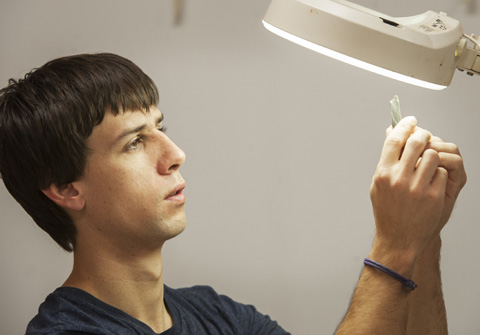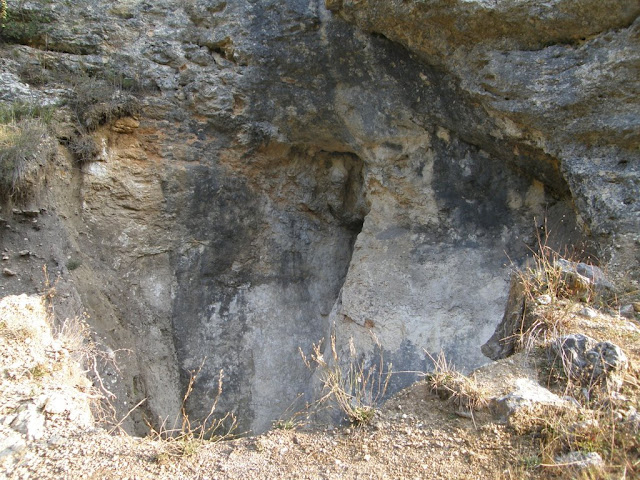The Atxoste shelter was used during more than 10,000 years by humans: in the Mesolithic, when they were hunter-gatherers, and in the Neolithic, by the time they were farmers. By analysing the marks found on the lithic artefacts on the site, a UPV/EHU researcher has deduced that Atxoste was a place of long-term occupation during both periods but never became a permanent abode.
The Atxoste cave, an important shelter over a 10,000-year period for both hunters and farmers
A researcher at the UPV/EHU-University of the Basque Country has concluded that the Atxoste shelter in Alava-Araba was the only one in the whole area that continued to be used by farming communities
First publication date: 02/02/2016

Shelters —natural, not particularly deep caves located among rocks and often at the foot of them— were widely used by human hunter-gatherer groups. Specifically, these groups used to choose the shelters that had resources nearby and they would spend time in them to exploit the animal and plant environment. For example, the Atxoste shelter in Alava-Araba is 12 metres from the river in the lower part of the valley and very close to the mid-mountain area of the basin. Due to this strategic location, the inhabitants of the shelter could exploit various resources in the Mesolithic period, in other words, when humans were hunter-gatherers," explained Unai Perales, researcher in the UPV/EHU's Department of Geography, Prehistory and Archaeology.
By the Neolithic period when humans had become farmers, they stopped using most of these shelters. The move to a different type of life led them to occupy space in a different way: they began to cultivate the land and keep domestic animals, etc. Specifically, 10-12 shelters that had been occupied during the Mesolithic have been found in this area, "and even when the Neolithic was well established in the area, humans continued to use Atxoste. This shows that it was an important or profitable settlement," pointed out the researcher.
During his PhD thesis, Perales carried out a use-wear analysis of the Atxoste site, in other words, he analysed the remains of lithic artefacts found on the site from the point of view of their use. "The use made of each tool leaves a specific mark on it. So by analysing these marks, it is possible to deduce what each tool was used for and how it was used," he explained. More than anything else, he studied the flint artefacts widely used by humans in the Mesolithic and Neolithic periods. Firstly, he analysed the principal marks using a magnifying glass and then carried out a more detailed analysis using a microscope.
In the research, they have concluded that during the Mesolithic period Atxoste was widely used for hunting: they have found various throwing weapons that bear impact marks, and also the remains of the animals caught. "But this was no ordinary settlement for short hunting stays," stressed Perales. "They also worked on hides and wood, and to do this they had to spend longer periods of time there." The tanning of hides is a complex process with many phases; at Atxoste they performed several of these phases although they did not finish them all there.
As regards the Neolithic remains, they have found marks corresponding to a whole range of activities, such as those occasioned by working on the hides, the hunted animals and the wood. Perales highlights the importance of the millstone found at the site: it is a stone weighing 20 kg, consisting of sandstone, and after conducting a geological study of it, they concluded that it had been brought from Elguea-Urquilla (20-30 km away). "If they transported such a heavy stone as this all the way there, one can assume that Atxoste was a settlement used for something more than hunting and that during that period they spent longer periods of time in the shelter," he explained. They also found bones of domestic sheep as well as flint artefacts used as sickles. "Thanks to that we know they were familiar with agriculture and the keeping of livestock."
Part of a series of interconnected shelters
Having analysed the remains discovered, Perales concluded that during the Mesolithic Atxoste "was a midway camp, neither a place of permanent abode nor a place for hunting. All this suggests that the human groups were connected with other shelters in the area and that they used to go from one to the other depending on the time of year." Other shelters were only used for hunting purposes and the groups lived in permanent dwellings outside. What is more, they discovered that the flint had been transported from Urbasa and Treviño as well as from Barrica. "This shows that these populations used to move around from one place to another and that they were in contact with other human groups," he added.
At the same time, the use of the Atxoste shelter well into the Neolithic sheds lights on the way the transition between the Mesolithic and the Neolithic took place. "The transition is recognised as having taken place in two ways: firstly, the farming human groups were gradually colonising areas, and secondly there was an acculturation of the hunter-gatherer populations. Atxoste is an example of that acculturation: a significant change has been detected in the archaeological record because new tools appeared out of the blue; but at the same time, they continued to exploit the same resources as the populations in the Mesolithic and they continued to use the shelter," he pointed out.
Additional information
The excavation carried out at the Atxoste shelter was led by the UPV/EHU lecturer Alfonso Alday. The geological analysis of the Neolithic millstone was carried out by L. Martínez-Torres, a UPV/EHU geologist.
Bibliography
Alday, A.; Maciá, L.; Portillo, M.; Albert, R.M.; Perales, U. (2014). "Agricultura neolítica: a propósito de un molino del yacimiento de Atxoste (Álava, País Vasco)". Munibe (Antropologia-Arkeologia), 65.
Alday, A.; Castaños, P.; Perales, U. (2012b). "Quand ils ne vivaient pas seulement de la chasse: preuves de domestication ancienne dans les gisements néolithiques d´Atxoste et de Mendandia (Pays Basque)". L´anthropologie, 116, 127‐147.
Perales, U.; Ibáñez, J.J.; Alday, A. (2014). "The use of flint artifacts from Early Neolithic levels at Atxoste (Basque Country): an interpretation of site function through use-wear analyses". In, Marreiros, J.; Bicho, N.; Gibaja, J.F. (eds.). International Conference on Use-Wear Analysis, Use-Wear 2012, Faro, Cambridge Scholars Publishing, 592-60.
Soto, A.; Alday, A.; Montes, L.; Utrilla, P.; Perales, U.; Domingo, R. (2015). "Epipalaeolithic assemblages on the Ebro Basin (Spain). The difficult identification of cultural entities". Quaternary International, 364, 144-152.
Photos: Unai Perales and Nuria González. UPV/EHU



